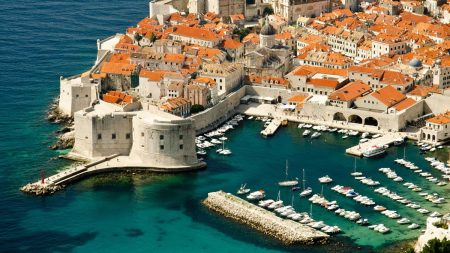Storm Floriane, a rapidly intensifying weather system, swept across northern France, triggering widespread disruptions and prompting authorities to issue orange alerts for strong winds in several departments. The storm, characterized by violent gusts reaching speeds of 80 to 110 km/h, primarily impacted regions such as Charleville-Mézières, Châlons-en-Champagne, and Bar-le-Duc. The storm’s trajectory projected its arrival in Belgium by late afternoon. Beyond the immediate threat of high winds, meteorologists warned of potential flooding and avalanches in northern France by early evening, with even a small section of Bordeaux experiencing effects. The rapid movement and intensity of Storm Floriane underscored the need for heightened vigilance and precautionary measures.
The storm’s impact on rail travel was particularly significant. SNCF, the national railway company, implemented a series of safety measures, including cancellations, service alterations, and speed restrictions to protect both passengers and staff. The disruptions rippled across the rail network, with a power outage between Nantes and Savenay forcing trains to operate at reduced speeds, delaying full service restoration until 8 pm. Another incident involving a fallen tree near Pont-Sainte-Maxence caused disruptions on the Creil-Compiègne line. SNCF advised passengers to verify train schedules before traveling and to remain alert to evolving weather conditions. Options for ticket exchange or postponement without fees were made available for those whose journeys were affected.
Beyond rail travel, the storm’s effects extended to road networks. The A51 motorway, a vital artery connecting Grenoble and Marseille, was closed in both directions near the Sinard tunnel due to debris on the road. Authorities strongly urged residents in orange alert zones to limit travel to essential trips only and emphasized the need for extra caution while driving, particularly in areas prone to flooding.
The storm’s rapid development and its potential for widespread disruption necessitated a proactive response from authorities and transportation providers. The orange alerts served as a critical warning, enabling residents to prepare for the impending conditions. The preemptive measures taken by SNCF, such as speed restrictions and service adjustments, aimed to mitigate risks and ensure the safety of rail travelers. The closure of the A51 motorway further highlighted the severity of the situation and the need to prioritize safety over mobility.
As Storm Floriane continued its eastward track, the focus remained on monitoring its progress and providing timely updates to the public. Journalists actively tracked the storm’s trajectory and its associated impacts, ensuring that individuals and communities had access to the latest information. This continuous flow of information enabled people to make informed decisions about travel plans and other activities, contributing to overall safety and preparedness. The collaborative efforts between meteorological agencies, transportation authorities, and media outlets played a crucial role in disseminating warnings and keeping the public informed.
In conclusion, Storm Floriane’s swift passage through northern France highlighted the need for robust emergency preparedness and responsive communication strategies. The storm’s intensity and the potential for widespread disruptions underscored the importance of proactive measures to protect lives and minimize damage. The combination of early warnings, travel advisories, and real-time updates facilitated informed decision-making and enabled individuals to navigate the challenges posed by the severe weather event. The coordinated response from various agencies and media outlets exemplified the critical role of collaboration in ensuring public safety during such emergencies.














